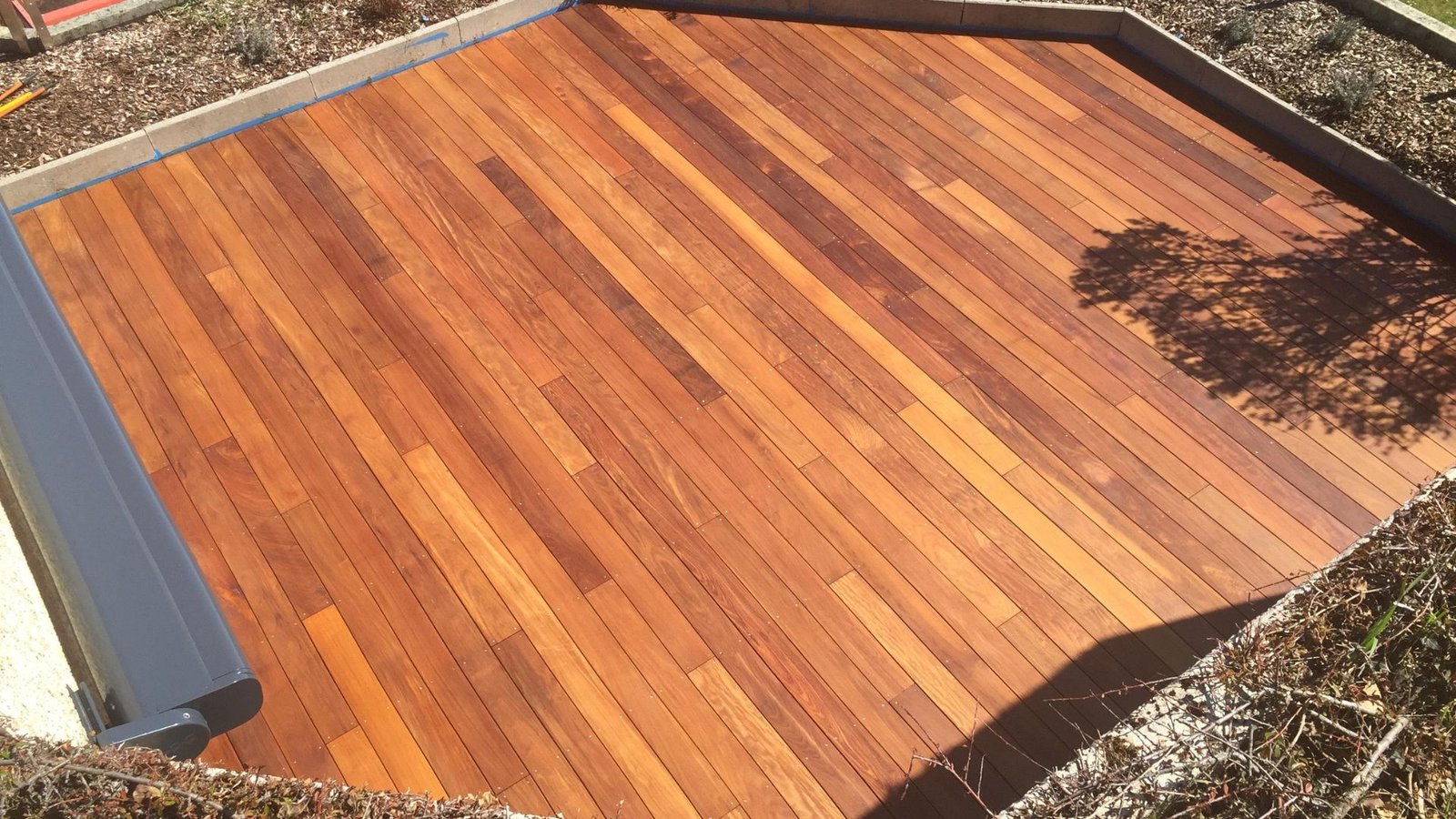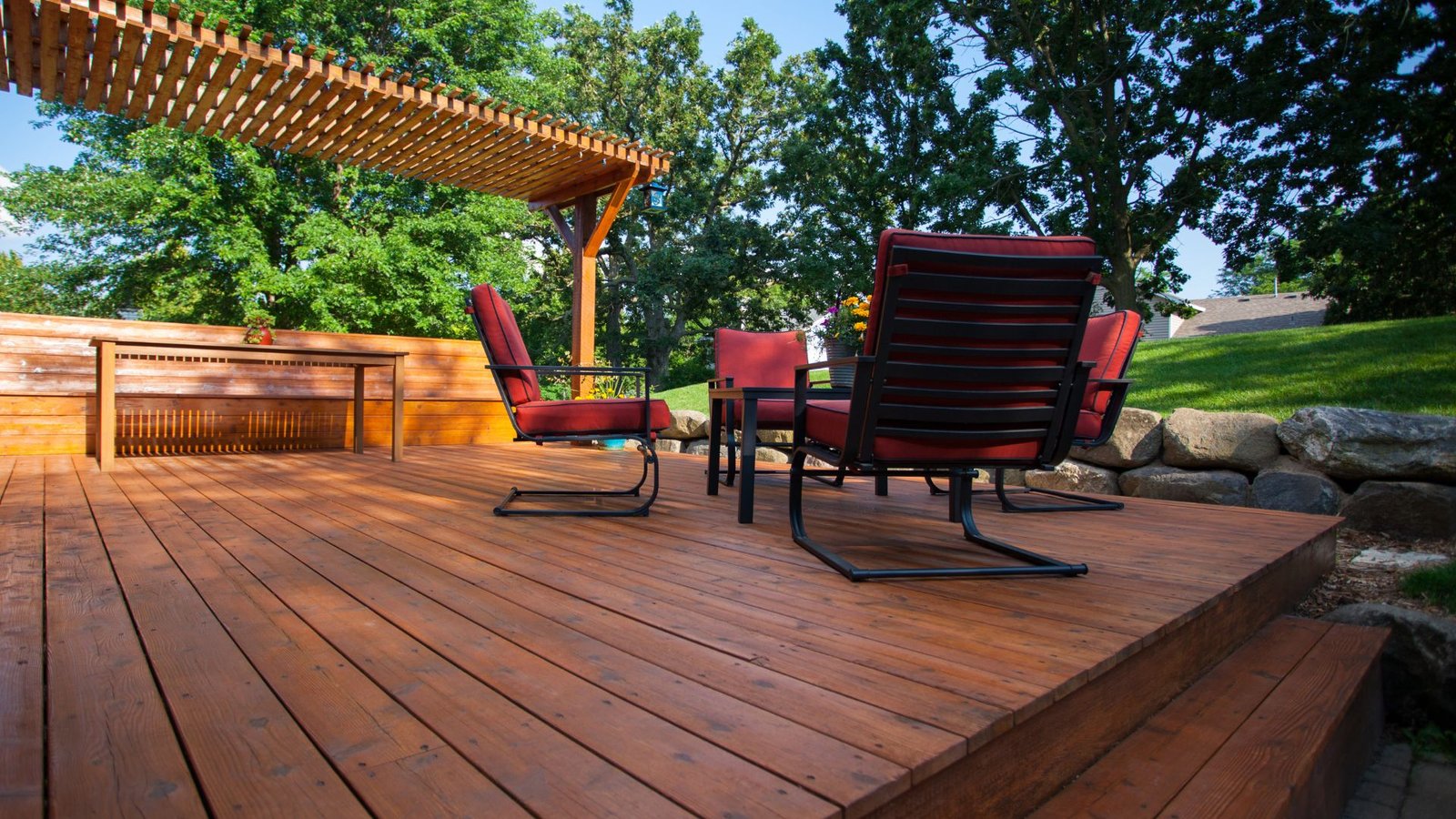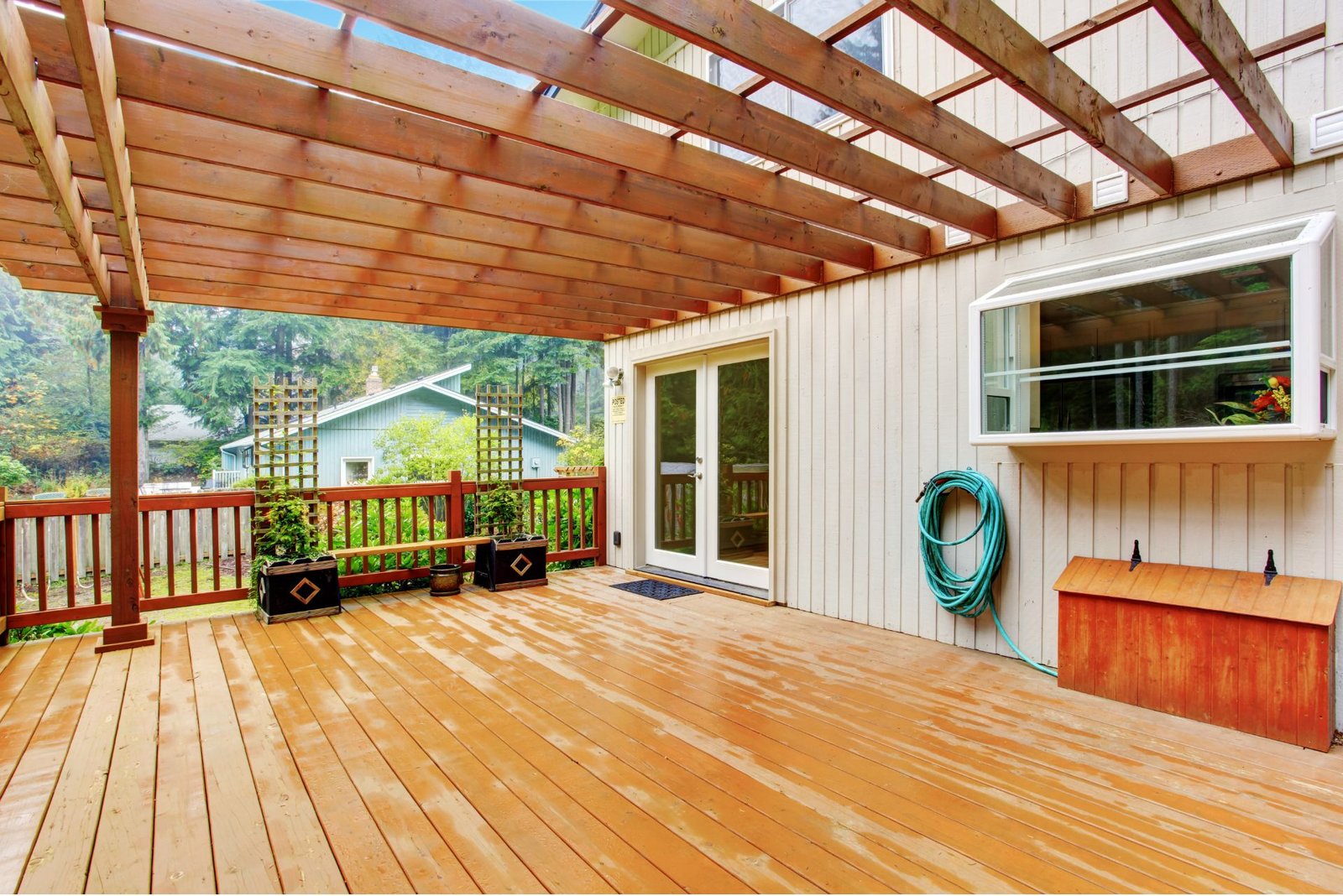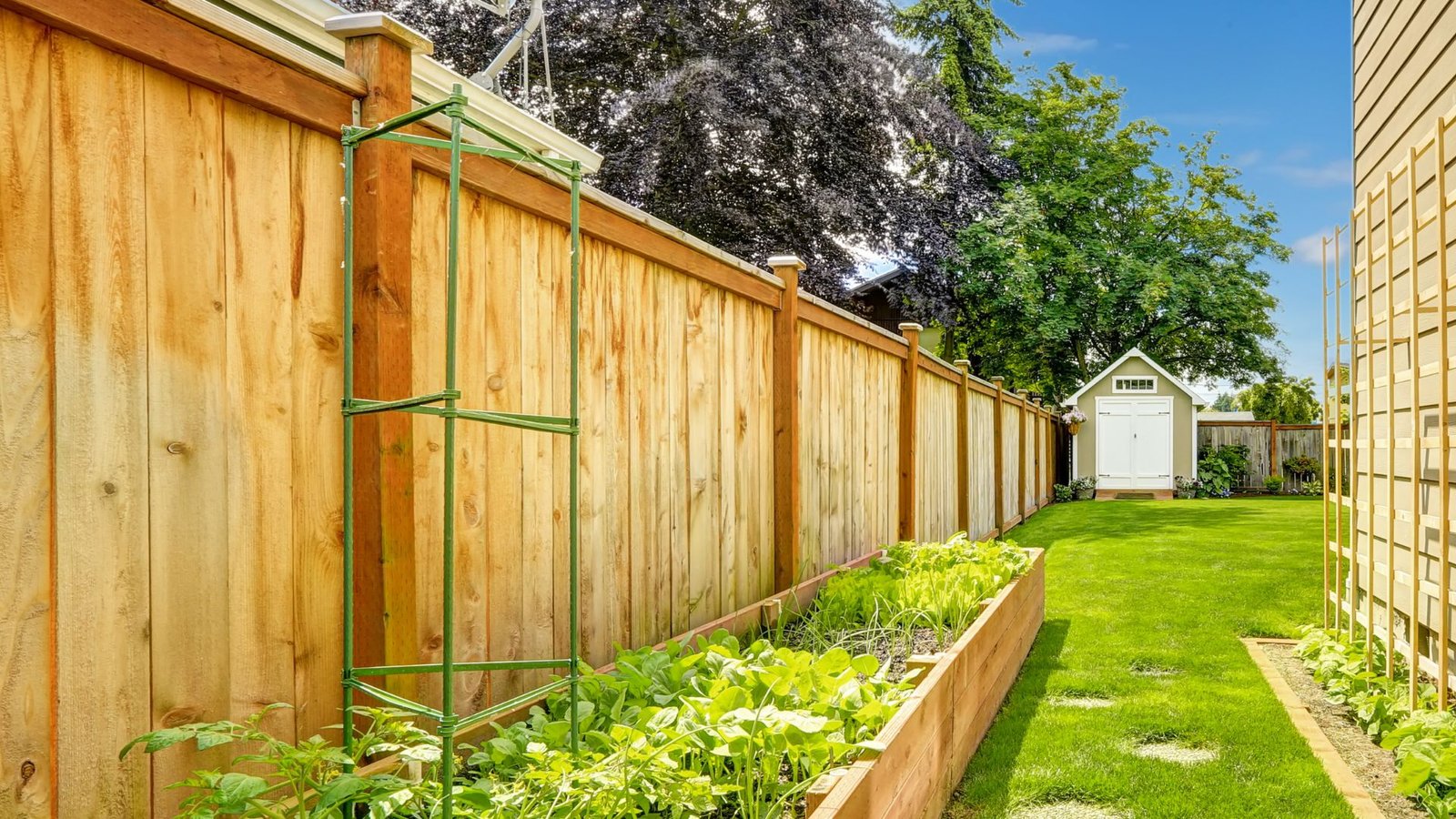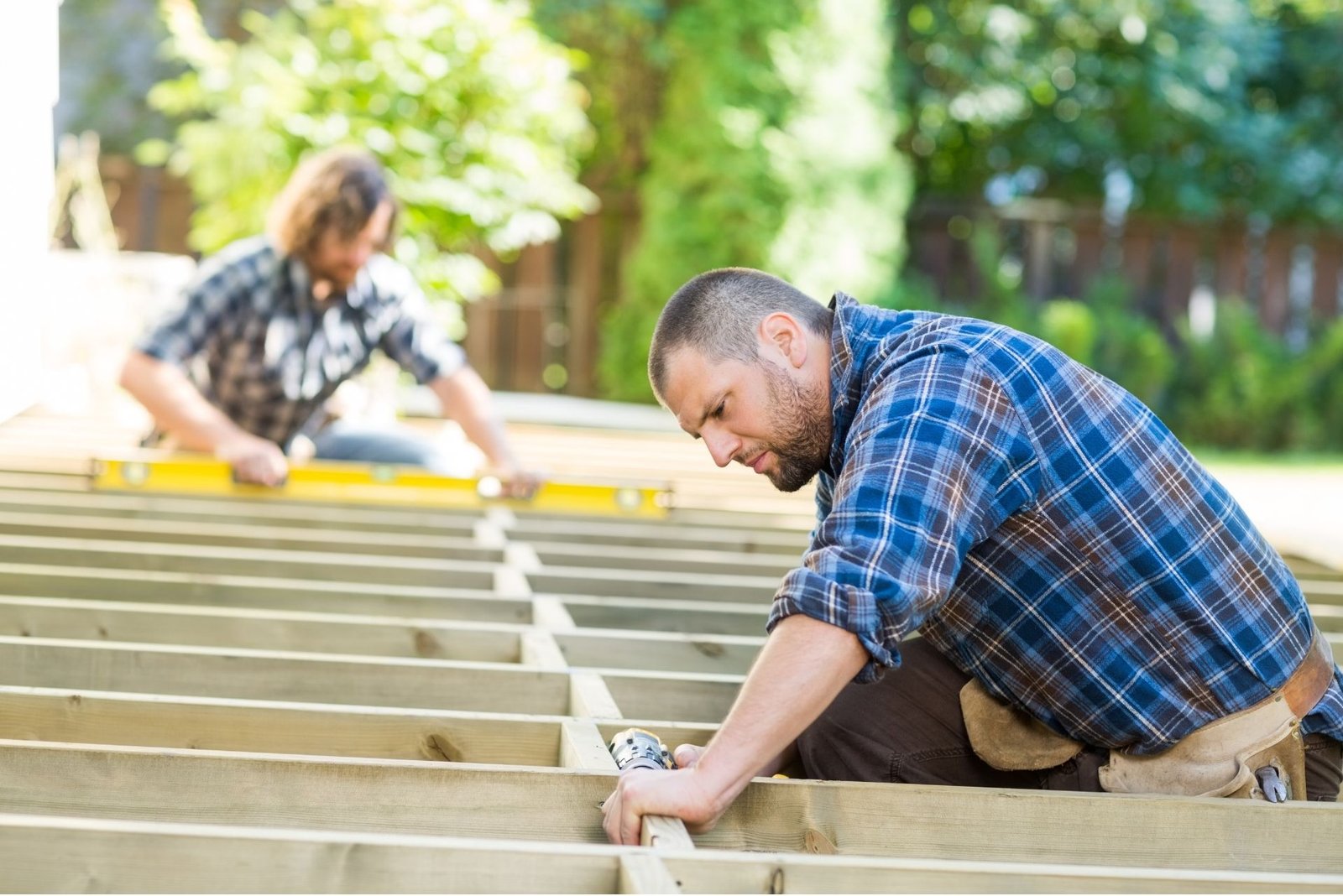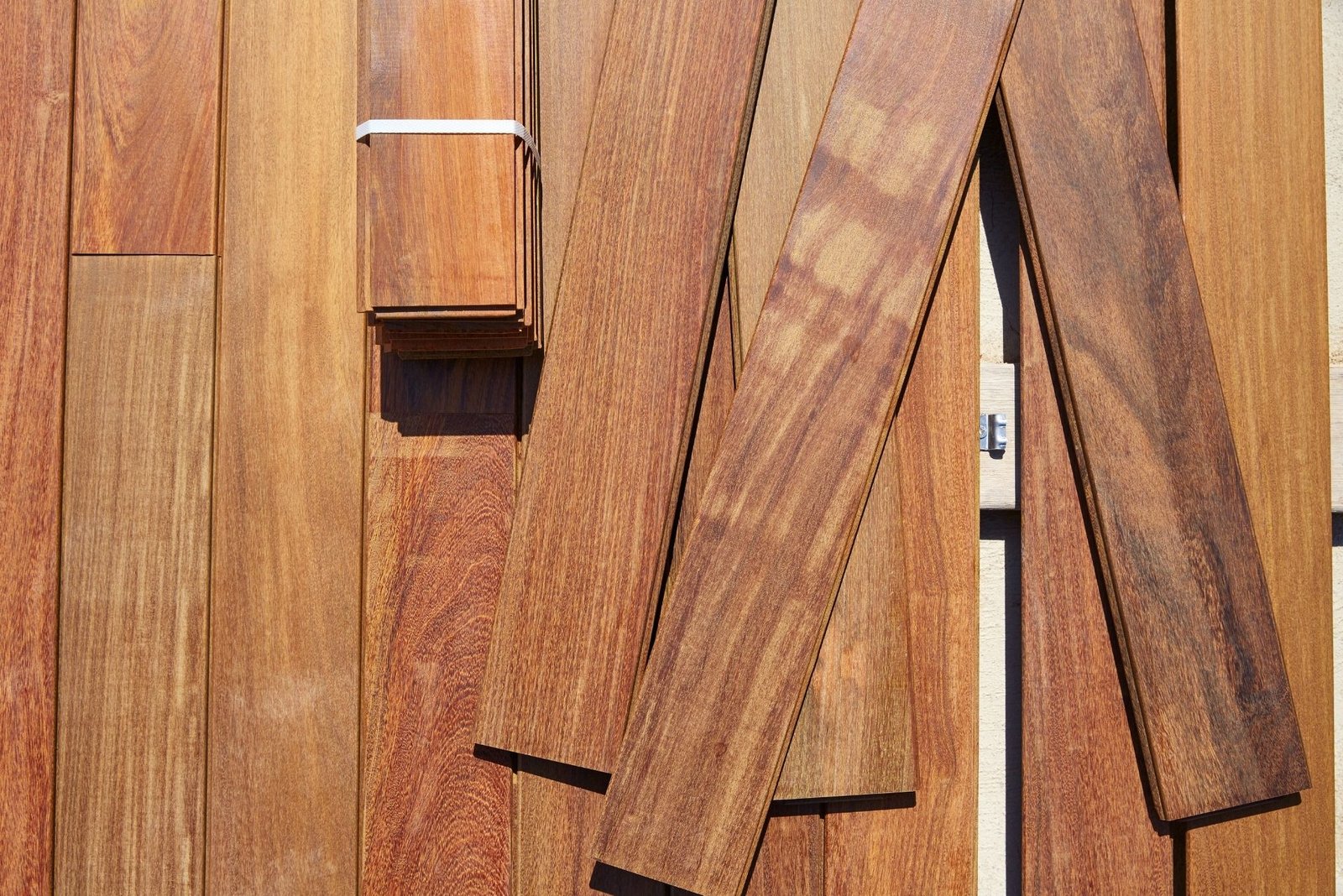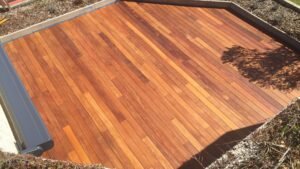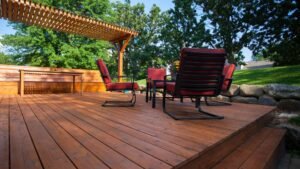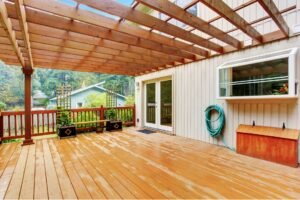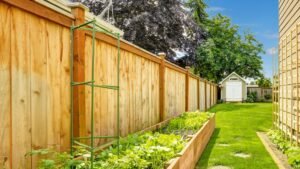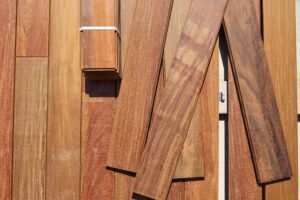Welcome to your comprehensive guide on choosing the best wood for decks in New Zealand. Whether you’re building a new deck or upgrading an existing one, selecting the right timber is crucial to creating a beautiful, durable outdoor space that can withstand NZ’s unique climate. From heavy rainfall and high UV exposure to coastal air, your deck needs to be built from materials that can stand the test of time. In this guide, we’ll walk you through the top timber options, including their pros, cons, and maintenance tips, so you can make an informed decision and enjoy your deck for years to come.
The best wood for decks in NZ includes durable options like Kwila, Vitex, Jarrah, treated Pine, and Macrocarpa. Kwila and Jarrah are hardwoods known for their long-lasting strength and resistance to rot, while Vitex offers a lighter, more affordable option. Treated Pine is budget-friendly, and Macrocarpa provides a sustainable, locally sourced alternative. Each wood type varies in durability, maintenance needs, and appearance, making it essential to choose based on your climate, style, and upkeep preferences.
Table of Contents
Factors To Consider When Choosing Deck Wood In New Zealand
When selecting the ideal wood for your decking project in New Zealand, several important factors come into play. The country’s unique climate, maintenance requirements, durability, aesthetic preferences, and the growing demand for sustainability all influence the best choice for your deck. Let’s dive deeper into these considerations.
Climate and Weather Conditions in New Zealand
New Zealand’s climate is known for its diversity, from the humid, subtropical conditions of the North Island to the cooler, wetter climates of the South Island. These weather conditions can significantly impact the performance and longevity of your deck.
In areas with high humidity and heavy rainfall, such as Auckland, it’s essential to choose wood that can withstand moisture without deteriorating quickly. Woods like Kwila or Vitex are naturally resistant to rot and decay, making them excellent choices for such environments. Similarly, if you live in a region that experiences high levels of sun exposure, such as the Hawke’s Bay, you’ll want to opt for a wood that doesn’t warp or crack under intense UV radiation. Woods like Teak or Jarrah are known for their ability to withstand prolonged sun exposure without losing their structural integrity.
For coastal areas, where salt air and wind can accelerate the degradation of materials, selecting a wood that holds up well against these harsh conditions is crucial. Species such as Ipe and Treated Pine are good options as they resist salt damage and stand strong against the elements.
Maintenance Needs
The amount of time and effort you’re willing to dedicate to maintaining your deck is another key consideration. Different types of wood require different levels of upkeep.
For example, softwoods, like Pine, require regular treatment to prevent decay and maintain their appearance. This might involve oiling, staining, or sealing the deck every year or two to ensure the wood remains protected from the elements.
On the other hand, hardwoods, such as Jarrah or Kwila, are much more durable and require less frequent maintenance. However, even these woods benefit from periodic care to preserve their natural beauty. Some homeowners prefer the natural aging process of wood, allowing it to develop a silver-grey patina over time, which reduces the need for regular treatments.
It’s important to assess your maintenance preferences before making a decision. A low-maintenance option may save time and effort in the long run, but might come at a higher initial cost.
Durability and Longevity
The lifespan of your deck will largely depend on the type of wood you choose. Some wood species are naturally more resistant to rot, decay, and insect infestations, which can significantly prolong the life of your deck.
Hardwoods, like Ipe, Garapa, and Blackbutt, are renowned for their exceptional durability, often lasting upwards of 30 years with proper care. These woods are naturally dense and resistant to moisture, which makes them ideal for regions with fluctuating weather conditions. Additionally, these species have natural oils that protect them from insects and fungi, reducing the need for chemical treatments.
Softwoods, such as Pine or Cedar, are more affordable but typically have a shorter lifespan unless treated with preservatives. Treated Pine is a popular choice in New Zealand due to its cost-effectiveness and improved durability from chemical treatments. However, even treated woods may need more regular maintenance to ensure longevity, especially in harsher climates.
Aesthetic Preferences
When it comes to the look and feel of your deck, the choice of wood plays a significant role. Different types of wood offer unique visual appeal, and understanding how they age can help you achieve the desired aesthetic.
Woods like Kwila and Vitex offer a rich, warm tone that can enhance the natural beauty of your outdoor space. These hardwoods tend to maintain their color longer, though they will still weather over time if not treated. Some homeowners prefer this weathered look, as it adds a rustic charm with a silver-grey hue.
If you desire a deck that retains its original color and luster, regular sealing or staining will be necessary. Cedar, for example, has a beautiful reddish tone when freshly installed, but without treatment, it will age to a silvery-grey finish.
Choosing wood based on aesthetics is a matter of personal preference. Think about how you envision your deck blending with your home and outdoor surroundings whether you want a modern, sleek appearance or a more natural, aged look.
Sustainability
With the increasing emphasis on environmental responsibility, choosing sustainably sourced wood has become a critical factor for many homeowners in New Zealand. Selecting eco-friendly materials ensures that your decking wood is harvested in a way that preserves forests and reduces environmental impact.
Look for certifications like the FSC (Forest Stewardship Council) label, which guarantees that the wood comes from responsibly managed forests. Woods such as Bamboo and New Zealand Pine are often considered more sustainable options. Accoya wood, which is modified to enhance its durability, is another eco-friendly choice, as it is sourced from fast-growing, sustainably managed forests.
In a market like New Zealand, where there is a growing demand for environmentally conscious products, opting for sustainable wood not only benefits the planet but can also add value to your home. Sustainability can often go hand-in-hand with durability, as many eco-friendly woods are treated to extend their lifespan without the need for harmful chemicals.
Choosing the right decking wood for your project involves more than just aesthetics. The climate, maintenance requirements, durability, and environmental impact all play a role in determining which wood is best suited for your needs. Whether you prioritize long-lasting hardwoods like Ipe or prefer the affordability and sustainability of treated Pine, understanding these factors will help you make an informed decision that enhances the beauty and functionality of your outdoor space for years to come.
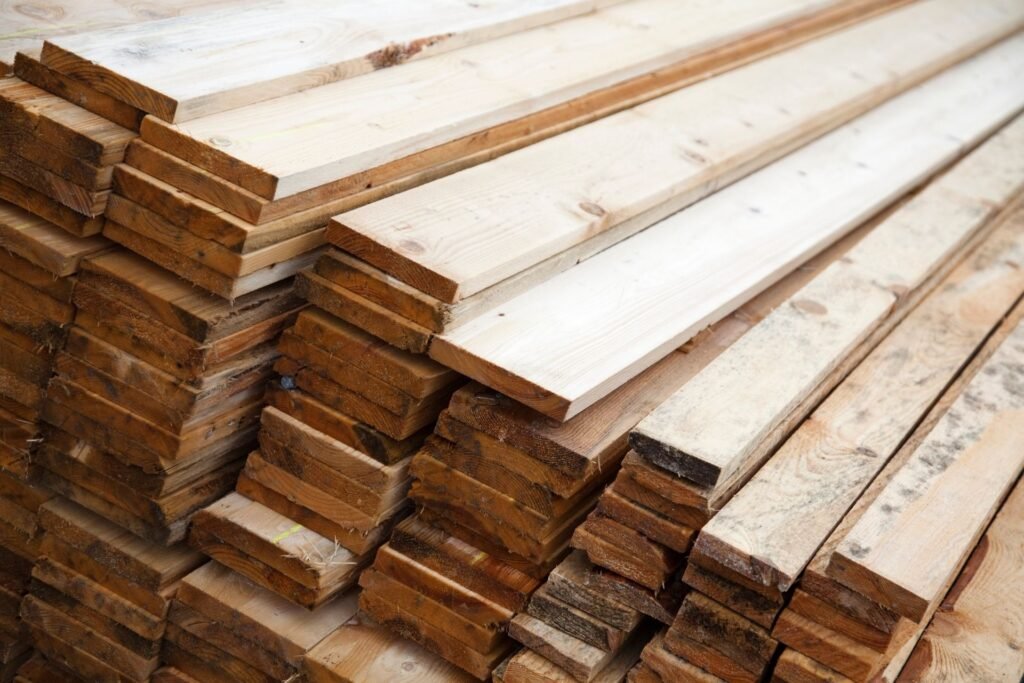
Top 5 Types Of Wood For Decks In NZ
When choosing the best wood for a deck in New Zealand, homeowners look for durability, beauty, and suitability for the unique climate. From tropical hardwoods to native softwoods, each type of decking timber has its advantages and considerations. In this article, we’ll explore the top five wood options for decks in NZ, focusing on their pros, cons, and best uses.
Kwila (Merbau)
Overview
Kwila, also known as Merbau, is one of the most popular decking woods in New Zealand. Sourced from tropical regions, it’s prized for its rich, luxurious look and incredible durability. It’s a preferred choice for homeowners who seek a long-lasting, premium deck with minimal compromise on aesthetics.
Pros
- Extremely durable and hardwearing: Kwila can withstand heavy foot traffic and harsh weather, making it ideal for long-lasting decks.
- Rot and insect resistance: Thanks to its natural oils, Kwila is highly resistant to decay and insect damage, making it suitable for NZ’s variable climate.
- Beautiful reddish-brown color: Kwila’s rich tones deepen over time, giving it a beautiful, aged patina that many homeowners love.
Cons
- Tannin bleed: One downside of Kwila is its tendency to bleed tannins, especially when first installed, which can stain nearby surfaces like patios or walls.
- Maintenance: To retain its deep reddish-brown color, Kwila requires regular oiling. Without it, the wood will fade to a more weathered silver-grey.
Homeowners looking for a luxurious, high-end deck material that can handle heavy foot traffic. Its durability and visual appeal make it ideal for those who don’t mind the upkeep required to maintain its rich color.
Vitex
Vitex is a tropical hardwood that has gained popularity in New Zealand decking projects due to its combination of strength, durability, and aesthetic appeal. It’s lighter than many hardwoods but still offers exceptional performance in outdoor settings.
Pros
- Lightweight yet strong: Vitex strikes the perfect balance between weight and strength, making it easier to handle while still providing excellent durability.
- Silver-grey patina: Over time, Vitex weathers to an attractive silver-grey, ideal for those who prefer a more aged, coastal look.
- Less tannin bleed: Unlike Kwila, Vitex is less prone to tannin bleed, reducing the risk of staining surrounding areas.
Cons
- Regular maintenance: While Vitex is durable, it does require regular oiling to retain its original color, especially if you prefer the wood’s natural blonde tones over its weathered grey look.
Those who want a strong, stylish deck without the heaviness of other hardwoods. Vitex is an excellent choice for medium-traffic areas or for homeowners seeking a weathered, seaside appearance.
Pine (Treated Radiata Pine)
Treated Radiata Pine is a popular decking option in New Zealand due to its affordability and wide availability. It’s a softwood, but with proper treatment, it becomes a durable and versatile choice for decking projects.
Pros
- Affordable and readily available: Treated pine is one of the most cost-effective options for decking in New Zealand, making it a go-to for budget-conscious homeowners.
- Treated for durability: With treatment, pine becomes resistant to rot, decay, and insect damage, extending its lifespan.
- Versatile for staining or painting: Pine can be easily stained or painted to match your home’s exterior, providing flexibility in design.
Cons
- Requires regular maintenance: Like all softwoods, treated pine needs regular sealing or staining to protect it from the elements.
- Not as durable as hardwoods: While treated pine is enhanced for outdoor use, it still doesn’t match the natural durability of hardwoods like Kwila or Vitex.
Homeowners looking for an affordable and flexible decking option. It’s ideal for DIY projects or those on a tight budget who still want a deck that can withstand New Zealand’s outdoor conditions.
Macrocarpa
Macrocarpa is a softwood native to New Zealand and is celebrated for its sustainability and natural beauty. Its unique characteristics make it a great choice for eco-conscious homeowners who want a locally sourced decking material.
Pros
- Environmentally friendly: Because it’s locally sourced, Macrocarpa has a lower environmental impact compared to imported woods.
- Naturally resistant to rot and insects: Thanks to the natural oils found in the wood, Macrocarpa resists decay and insect attacks without the need for chemical treatment.
- Attractive golden-brown hue: This wood boasts a warm, golden tone that adds a rustic charm to any outdoor space.
Cons
- Softer than hardwoods: Being a softwood, Macrocarpa is more prone to dents and wear over time, especially in high-traffic areas.
- Needs sealing: To protect against weathering and to maintain its appearance, Macrocarpa requires regular sealing.
Eco-conscious buyers looking for a sustainable, local wood with a rustic feel. It’s perfect for decks in lower-traffic areas or for those who appreciate the natural beauty of softwood.
Jarrah
Jarrah is a dense, hardwearing hardwood imported from Australia and is highly sought after for premium decking projects. Its deep, reddish hue and remarkable durability make it a favorite among homeowners who want a deck that will stand the test of time.
Pros
- Extremely hard and durable: Jarrah is one of the toughest woods available, capable of lasting for decades with minimal wear.
- Natural resistance to fire, insects, and decay: Its density and natural properties make it highly resistant to external damage, perfect for long-lasting outdoor use.
- Rich reddish color: Jarrah’s distinctive color adds a touch of elegance to any deck, and it can maintain its hue with proper care.
Cons
- Heavy and expensive: Jarrah is heavier than most other decking woods, making it harder to work with, and its premium quality comes with a higher price tag.
- Requires maintenance: While it’s highly durable, Jarrah needs regular oiling to preserve its rich color and prevent fading.
High-end decking projects where longevity and aesthetics are key. Jarrah is perfect for those who want a luxurious, top-of-the-line deck that will last for decades with the right care. By considering these top five types of wood for decks in NZ, homeowners can select the best material for their needs, balancing factors like durability, appearance, cost, and environmental impact. Each of these woods offers distinct benefits and challenges, making it essential to choose the one that fits your lifestyle and outdoor living space.

How To Maintain Your Wooden Deck In New Zealand
Owning a wooden deck in New Zealand brings a sense of warmth and natural beauty to your outdoor space. However, with the varying climate conditions across the country, from the wet winters to the harsh UV rays in the summer, it’s essential to provide consistent care to keep your deck looking its best and ensure its longevity. Below, we’ll guide you through the key steps for maintaining your wooden deck in NZ, including general care, annual maintenance, and knowing when to repair or replace damaged boards.
General Care for Your Wooden Deck
To keep your deck in good condition, regular upkeep is a must. Follow these general care tips to prevent common issues like mold growth, wood decay, and discoloration.
- Regular Sweeping: One of the simplest yet most effective maintenance habits is sweeping your deck regularly. Leaves, dirt, and debris that accumulate can trap moisture and cause mold or mildew to develop, particularly in NZ’s humid coastal areas. Sweep your deck at least once a week, or more frequently during the autumn when leaves are falling.
- Cleaning Your Deck: Periodically clean your deck with a gentle deck cleaner or a mix of warm water and mild soap. Avoid using harsh chemicals, as these can damage the wood’s surface. A soft-bristle brush can help scrub away dirt, but make sure to rinse thoroughly with a garden hose to prevent soap residue from drying on the wood.
- Preventing Water Pooling: Water is one of the biggest threats to wooden decks. To avoid damage, ensure your deck has proper drainage. Water pooling on the surface can cause wood to warp or rot over time. Check the slope of your deck to make sure water flows away from the surface, and consider using a deck sealer to help repel moisture.
Annual Maintenance for Your Deck
In addition to regular cleaning, your wooden deck will benefit from more thorough annual maintenance to preserve its appearance and structural integrity.
- Oiling or Staining Your Deck: Oiling or staining your deck once a year is crucial for protecting the wood from New Zealand’s elements. A quality oil or stain not only enhances the color of the wood but also helps safeguard it from moisture and UV rays, which can cause the wood to dry out and crack over time. Before applying any product, ensure your deck is clean and dry. Use a natural-bristle brush or a roller to apply the stain or oil evenly, and let it fully absorb before using the deck.
- Choosing the Best Products for NZ Conditions: In New Zealand’s climate, it’s important to choose a product designed to withstand both the rain and the intense summer sun. Look for deck oils or stains that offer UV protection and water resistance. Products with a high oil content are often recommended for their ability to penetrate deep into the wood, offering long-lasting protection. Popular choices include Resene Decking Stain, Cabot’s Deck & Exterior Stain, or Wattyl Forestwood Decking Oil—all of which are formulated specifically for NZ weather conditions.
- Check for Signs of Wear: Each year, inspect your deck closely for signs of wear or damage. Look out for areas where the finish may be wearing thin, especially on high-traffic spots. If you notice any sections where the wood looks dull or dry, it’s time to reapply oil or stain.
When to Repair or Replace Deck Boards
Even with diligent care, wooden decks are susceptible to wear and tear over time. Knowing when to repair or replace parts of your deck is essential for keeping it safe and attractive.
- Repairing Deck Boards: Small cracks, splits, or slight warping can often be repaired without the need for full replacement. If the damage is localized, consider sanding down rough edges or using wood filler to patch cracks. Be sure to follow up with a fresh coat of oil or stain to protect the repaired area. Loose nails or screws can be tightened, but for severely warped boards, replacing individual planks might be the best solution.
- Replacing Deck Boards: If you notice widespread issues like significant rot, deep cracks, or boards that are severely warped, it may be time to replace the damaged boards. To check for rot, use a screwdriver to press into the wood—if it sinks easily, the wood is rotten and should be replaced. Pay special attention to areas around the posts and joists where moisture can accumulate.
- Signs of Rot, Warping, or Splitting: Regularly inspect your deck for early signs of rot, such as soft, discolored, or spongy wood. Warping often occurs when water sits on the deck for long periods, leading the boards to bend or bow. Splitting, on the other hand, is typically caused by exposure to sun and fluctuating temperatures, which can cause the wood to expand and contract. Addressing these problems early can prevent more extensive damage and costly repairs.
Maintaining a wooden deck in New Zealand may require effort, but the rewards are worth it. With regular care, annual oiling or staining, and timely repairs, your deck will stay looking beautiful for years to come. Whether you’re enjoying a summer BBQ or simply relaxing with a book, following these steps will ensure your deck remains a safe and attractive outdoor space.

Alternatives To Wooden Decking
When considering a deck for your outdoor space, wooden decking has traditionally been the go-to choice. However, in recent years, several alternatives have emerged, offering homeowners a wider range of options, especially for those looking for low-maintenance solutions or more durable materials. Below, we’ll explore a few of the most popular alternatives: composite decking, plastic, and PVC decking. We’ll also break down the pros and cons of these materials in comparison to traditional wood.
A Low-Maintenance Alternative
One of the most popular alternatives to wood decking is composite decking. Made from a blend of wood fibers and recycled plastic, composite decking is designed to mimic the look of real wood while providing superior resistance to the elements. For homeowners who prefer a deck that requires little upkeep, composite decking is an ideal choice. It resists fading, staining, and scratching far better than wood, meaning it will look new for years with minimal maintenance. There’s no need to sand, stain, or seal the deck, which saves both time and money in the long run.
However, while composite decking is durable, it’s important to note that it may not offer the same authentic appearance as natural wood. Some homeowners find that the synthetic feel of composite decking lacks the warmth and natural texture of real timber. Additionally, composite decking can be more expensive upfront than wood, though the long-term savings in maintenance costs can offset this initial investment.
Plastic and PVC Decking
Plastic and PVC decking are other non-wood alternatives that have gained popularity due to their high durability and ease of care. Unlike composite decking, which incorporates wood fibers, plastic and PVC decking are made entirely from synthetic materials, giving them exceptional resistance to moisture, rot, and insect damage. These decking materials are ideal for homeowners who live in areas with extreme weather conditions, as they won’t warp, crack, or fade even in the harshest climates.
PVC decking, in particular, is known for its lightweight nature and ability to withstand heavy foot traffic. It’s also available in a variety of colors and textures, so homeowners can choose a design that complements their outdoor aesthetic. Like composite decking, plastic and PVC options require little to no maintenance, just an occasional wash with soap and water.
However, similar to composite decking, these materials can feel less natural underfoot than real wood, and some homeowners may find the synthetic look less appealing. Additionally, while plastic and PVC decking are extremely durable, they can be more expensive than both wood and composite options.
Comparing Wood to Alternative Materials
When deciding between wood and alternative decking materials like composite, plastic, and PVC, it’s essential to weigh the pros and cons of each in terms of longevity, aesthetics, and environmental impact.
- Longevity: In terms of lifespan, composite, plastic, and PVC decking outperform wood. Traditional wood decks require regular maintenance to prevent rot, warping, and insect damage. Even with proper care, wood decking may only last 10-15 years before needing significant repairs or replacement. In contrast, composite and PVC decks can last 25-30 years or longer with minimal maintenance, making them a cost-effective option over time.
- Aesthetics: When it comes to appearance, natural wood offers unmatched beauty, with its organic grain patterns and ability to weather into a silver-gray patina over time. While composite and plastic decking have improved in terms of aesthetics, some homeowners still prefer the authenticity of real wood. However, for those who prioritize convenience, the low-maintenance nature of synthetic decking materials may outweigh the aesthetic differences.
- Environmental Impact: From an environmental perspective, the debate between wood and alternative decking materials is nuanced. Wood is a renewable resource, especially when sourced from sustainably managed forests. However, wood decking often requires chemical treatments to prevent rot and insect damage, which can be harmful to the environment. On the other hand, composite decking is typically made from recycled materials, making it an eco-friendly option. PVC and plastic decking, while not biodegradable, offer longevity that reduces the need for replacement, thus minimizing waste over time.
While wood decking remains a popular choice for many homeowners, alternatives such as composite, plastic, and PVC decking provide low-maintenance, durable solutions that can enhance your outdoor space. When making a decision, consider the trade-offs in terms of aesthetics, longevity, and environmental impact to choose the option that best fits your needs and lifestyle. Whether you prioritize the natural beauty of wood or the hassle-free maintenance of synthetic materials, there’s a decking option out there that’s perfect for your home.
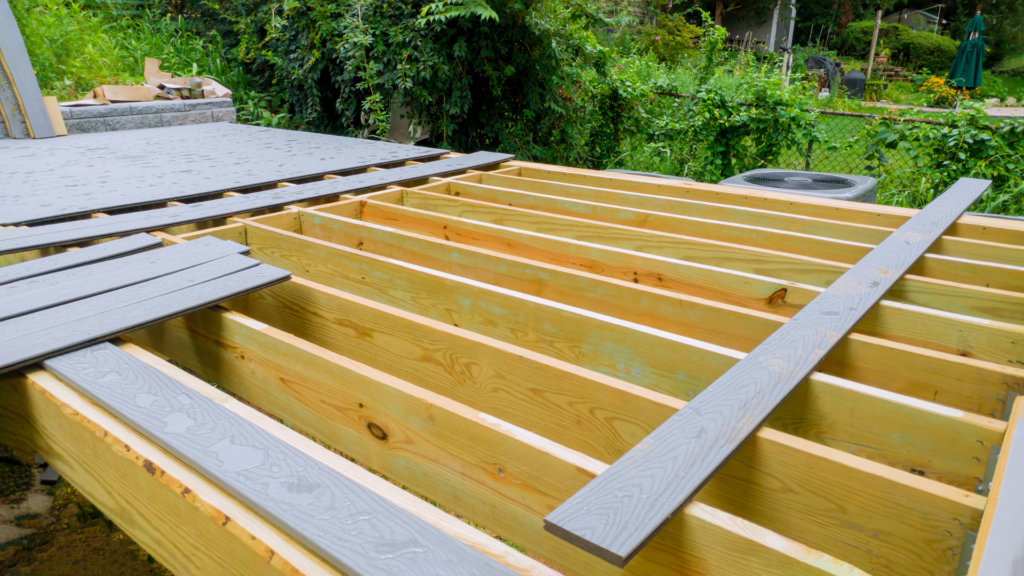
Sustainability And Environmental Considerations For Timber Decking
Choosing FSC-Certified Timber
When selecting materials for your decking project, it’s essential to consider the environmental impact of your choices. One of the most sustainable options available is timber certified by the Forest Stewardship Council (FSC) or the Programme for the Endorsement of Forest Certification (PEFC). These certifications ensure that the wood has been sourced from responsibly managed forests, where strict environmental, social, and economic standards are followed. FSC-certified timber, in particular, promotes sustainable forest management practices, reducing deforestation and helping to maintain biodiversity.
Opting for FSC or PEFC-certified timber not only supports environmental conservation but also ensures the long-term health of forests worldwide. In addition, choosing certified wood reflects a commitment to sustainable building practices, something increasingly valued by homeowners and construction professionals alike.
Impact of Deforestation
Deforestation is a pressing global issue with far-reaching consequences, and it’s especially relevant in a country like New Zealand, which prides itself on its natural beauty and diverse ecosystems. When forests are cleared or degraded, wildlife habitats are destroyed, carbon sequestration is reduced, and soil erosion increases. All of this contributes to climate change and the loss of biodiversity.
By choosing sustainably sourced wood, you are actively reducing the demand for illegally logged timber and helping to preserve forests for future generations. Sustainable timber production ensures that forests are allowed to regenerate, providing a continuous source of wood without depleting the natural environment. In a country where outdoor living spaces are cherished, it’s vital to protect the very ecosystems that make these spaces so inviting.
Reclaimed Wood
For those seeking an even more eco-friendly option, reclaimed wood presents a fantastic alternative for decking projects. Reclaimed timber is sourced from old buildings, bridges, barns, and other structures, repurposing wood that might otherwise go to waste. Not only does this reduce the demand for newly harvested timber, but it also lowers the carbon footprint associated with processing and transporting raw materials.
In addition to its environmental benefits, reclaimed wood offers a unique aesthetic appeal. It often comes with a rich history and a weathered character that can add a lot of charm to your outdoor deck. Using reclaimed wood allows you to blend sustainability with style, creating a truly one-of-a-kind space that stands out both in appearance and environmental consciousness.
Making sustainable choices for your decking project whether through FSC-certified timber or reclaimed wood helps protect the environment while delivering beautiful, durable results. Every decision to use eco-friendly materials contributes to a healthier planet and supports the future of our natural world.
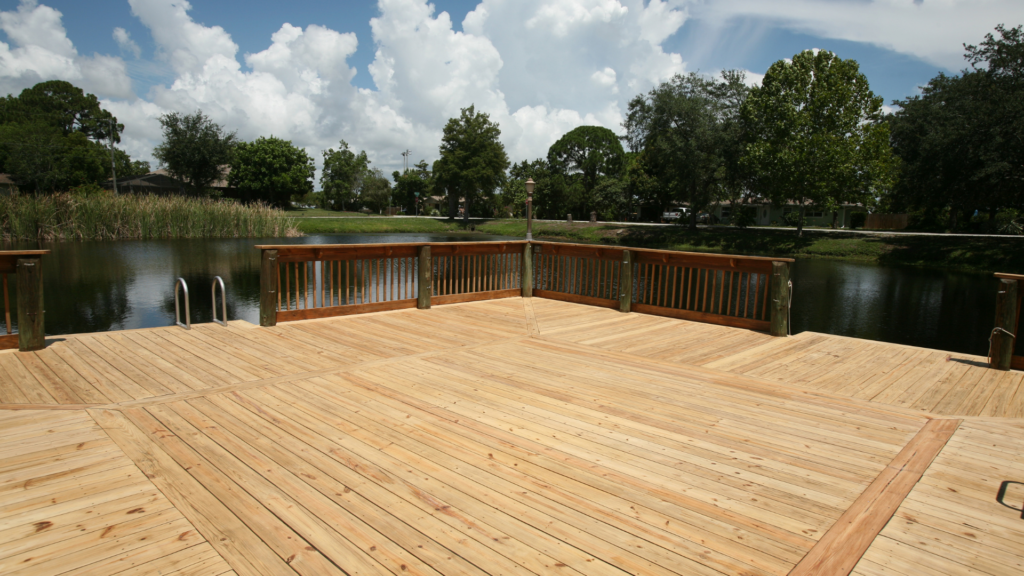
FAQs: About Best Wood For Decks NZ
What is the most durable wood for decking in New Zealand?
Kwila is considered one of the most durable woods for decking in New Zealand due to its natural resistance to rot, insects, and harsh weather conditions. Jarrah is another highly durable option, though it is heavier and more expensive. Both hardwoods can last decades with proper care.
How do New Zealand’s weather conditions affect decking wood?
New Zealand’s weather conditions ranging from heavy rainfall to high UV exposure can cause wood to warp, crack, or decay if not properly maintained. Coastal areas are especially harsh due to salt air, while the North Island’s higher humidity can increase the risk of mold and rot. Choosing a weather-resistant wood and regularly maintaining it will extend its lifespan.
How often do I need to maintain my wooden deck?
Wooden decks in New Zealand should be maintained annually. This typically involves cleaning, re-staining, or oiling the wood to protect it from moisture, UV rays, and general wear and tear. Regular sweeping and checking for water pooling will help keep the deck in good condition year-round.
Is Kwila decking a good option for New Zealand homes?
Yes, Kwila is one of the most popular decking woods in New Zealand due to its durability and rich reddish-brown color. However, it requires regular maintenance to prevent tannin bleed (which can stain surrounding surfaces) and to preserve its vibrant color.
What is the best budget-friendly wood for decks in NZ?
Treated Pine (Radiata Pine) is the most affordable option for decking in New Zealand. It’s widely available and treated to resist rot and insect damage. While it requires more maintenance than hardwoods, it is highly versatile and can be stained or painted to achieve a desired look.
How does Vitex compare to Kwila for decking?
Vitex is a lighter, more affordable hardwood option compared to Kwila. It is also durable and ages to a silver-grey patina, which some homeowners prefer. Unlike Kwila, Vitex does not bleed tannins as heavily, making it a lower-maintenance option for those seeking a stylish, natural deck.
What are the environmental considerations when choosing wood for decks?
When choosing decking wood in New Zealand, it’s important to consider sustainability. Opting for FSC-certified or PEFC-certified timber ensures that the wood is sourced from responsibly managed forests. Locally sourced woods like Macrocarpa are also eco-friendly choices due to their lower transportation footprint.
What are some alternatives to wood for decking in New Zealand?
Popular alternatives to wood for decking include composite decking and PVC decking. Composite decking is made from recycled materials and is low maintenance, while PVC decking offers durability and resistance to rot and insects. Both options are less prone to weathering but may not have the same natural aesthetic as wood.
Does decking wood need to be treated for New Zealand’s climate?
Yes, decking wood typically needs to be treated to withstand New Zealand’s climate. Hardwood options like Kwila, Jarrah, and Vitex have natural resistance, but softwoods like Pine need to be pressure-treated to protect against rot, moisture, and insects. Annual maintenance, such as oiling or staining, is also necessary for all wood types to maintain durability.
Can I use reclaimed wood for my deck in New Zealand?
Yes, reclaimed wood is an environmentally friendly option for decking, offering a unique, weathered look. When using reclaimed wood, ensure that it is structurally sound and free of pests. It’s often a great choice for eco-conscious homeowners who want to reduce their environmental impact while adding character to their outdoor spaces.
Conclusion
Selecting the best wood for your deck ultimately comes down to your personal needs, aesthetic preferences, and long-term goals for your outdoor space. We’ve explored various types of wood, each with its own set of benefits, whether you’re prioritizing durability, affordability, or visual appeal. From the rugged resilience of tropical hardwoods to the classic charm of cedar, and even the low-maintenance option of composite decking, there’s a material to suit every lifestyle and environment. It’s important to consult with local suppliers to better understand which woods thrive in your specific climate and consider how much time and effort you’re willing to invest in maintenance. By weighing these factors, you’ll be able to choose a decking material that not only enhances the beauty of your outdoor space but also provides long-lasting value. We encourage you to take the next step: reach out to local experts, compare your options, and make an informed decision that will bring satisfaction for years to come. If you have any questions or personal experiences to share, feel free to leave a comment below. We’d love to hear about your decking journey and are happy to help with any further advice.
About the Author:
Mike Veail is a recognized digital marketing expert with over 6 years of experience in helping tradespeople and small businesses thrive online. A former quantity surveyor, Mike combines deep industry knowledge with hands-on expertise in SEO and Google Ads. His marketing strategies are tailored to the specific needs of the trades sector, helping businesses increase visibility and generate more leads through proven, ethical methods.
Mike has successfully partnered with numerous companies, establishing a track record of delivering measurable results. His work has been featured across various platforms that showcase his expertise in lead generation and online marketing for the trades sector.
Learn more about Mike's experience and services at https://theleadguy.online or follow him on social media:


